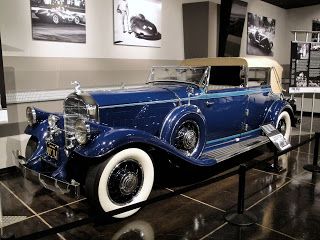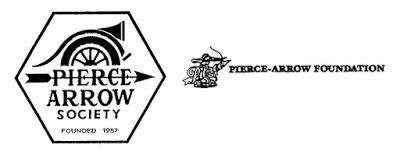Although the PIERCE-ARROW automobile was last produced in 1938, the Board sustained this opposition to registration of the mark PIERCE-ARROW for automobiles, finding a likelihood of confusion with the registered collective membership mark PIERCE ARROW SOCIETY for "indicating membership in a national organization whose aim is to foster and preserve interest in Pierce Arrow Motor Cars." However, a "false suggestion of a connection" claim under Section 2(a) was denied because the Society failed to show that The Pierce Arrow Society is famous or has any reputation, and failed to show that the mark PIERCE-ARROW points uniquely and unmistakably to the Society. The Pierce-Arrow Society v. Spintek Filtration, Inc., Opposition No. 91224343 (August 12, 2019) [precedential] (Opinion by Judge Albert Zervas).

Opposer is a non-profit organization founded in 1957. It operates the Pierce-Arrow Museum in Hickory Corners, Michigan, has published a monthly magazine about the automobile, and displays PIERCE-ARROW automobiles at the Annual Flea Market in Hershey, Pennsylvania. The Society assists members in preserving and restoring their autos, publishes service bulletins, facilitates the sale of autos and parts, and sells some parts directly to owners of PIERCE-ARROW automobiles.
The Society is not a legal successor to The Pierce-Arrow Motor Company, nor did it acquire any of its assets or any rights in the PIERCE-ARROW mark.
Section 2(a) False Suggestion of a Connection: Section 2(a) bars registration of a mark that may falsely suggest a connection with "persons, living or dead, institutions, beliefs, or national symbols . . . ." To support such a claim, the opposer must establish that:
1. The mark is the same as, or a close approximation of, the name or identity previously used by another person or institution;
2. The mark would be recognized as such, in that it points uniquely and unmistakably to that person or institution;3. The person or institution named by the mark is not connected with the activities performed by the applicant under the mark; and
4. The fame or reputation of the person or institution is such that, when the mark is used with the applicant's goods or services, a connection with the person or institution would be presumed. Univ. of Notre Dame du Lac v. J.C. Gourmet Food Imps., 217 USPQ at 508-10.
The Board found that PIERCE-ARROW is a close approximation of opposer's name. The article "The" and the word "Society" have no source identifying significance. The Board also found that Applicant Spintek is not connected with the Society. Thus elements 1 and 3 of the Section 2(a) test were met.
However, as to the second element, the Society failed to show that PIERCE-ARROW points uniquely and unmistakably to it. Although the Society maintained that the mark would be recognized as the name of the antique automobiles and that it is the "de facto successor" to the motor car company, the Board was not impressed. It observed that when the company ceased to exist, its rights were extinguished. See In re Wielinski. There was no assignment of any interest in these rights to any another entity. The Society did not prove that it may claim rights in the name or identity of the defunct company. The use of marks containing the words PIERCE-ARROW as collective memberships marks did not effectuate a transfer of the goodwill associated with PIERCE-ARROW for automobiles.
Likewise, the Society did not satisfy the fourth element of the Section 2(a) test: it failed to show that it has any fame or reputation. The Board noted that there are only 2,400 Pierce-Arrow automobiles in existence, that the Society has only 1,000 members, and that its advertising is limited. The Society failed to establish how may individuals visit the flea market and museum. Moreover, the Society failed to show that the defunct company enjoyed a fame or reputation that was transferred to opposer.
And so, because the Society did not satisfy all four elements of the test, the Board dismissed its Section 2(a) claim.

Section 2(d) Likelihood of Confusion: The likelihood of confusion analysis involving a collective membership mark and a trademark is not based on confusion as to the source of the goods or services provided by the organization; rather the issue is whether relevant consumers are likely to believe that the trademark owner's goods "emanate from or are endorsed by or in some other way associated with the collective organization." Carefirst of Md. Inc. v. FirstHealth of the Carolinas, Inc., 77 USPQ2d 1492, 1512-13 (TTAB 2005).
Thus, we consider whether Applicant's goods and the indication of membership in an organization whose aim is to foster and preserve interest in PIERCE-ARROW motor cars are sufficiently related that, if similar marks were used in connection with them, such prospective purchasers of Applicant's automobiles and current or prospective members of Opposer's organization would be likely to believe that Applicant's automobiles are sponsored by or in some way affiliated with Opposer's organization.
As to the marks, the Board not surprisingly found PIERCE ARROW to be the dominant portion of the Society's, and it deemed the marks "highly similar" in appearance, sound, connotation, and commercial impression. As to the goods and services, the respective identifications in the application and the pleaded registration "reflect a clear and immediate relationship." "Opposer's collective membership mark identifies its organization's focus on PIERCE ARROW automobiles. Applicant Spintek's goods are PIERCE-ARROW automobiles." Notably, the identification in the Society's registration does not specify whether the motor cars in which its members are interested are new or used, and so it encompasses applicant's automobiles.
As to trade channels and classes of consumers, the Board agreed with Applicant Spintek that the trade channels differ, but it found that the consumers of the Society's services overlap with the (potential) purchasers of Spintek's goods:
Members of Opposer's organization may not own only antique automobiles, they may also own modern automobiles. Thus, once Applicant promotes its automobiles, it is likely that the same individuals will be exposed to both Applicant's and Opposer's marks for their respective goods and services.
Finally, as to the conditions of sale, Spintek argued that automobiles are costly and are purchased with care, but the Board noted that the Society's annual membership fee is a mere $45, suggesting less care by consumers in their decisions to join the Society. In any case, even sophisticated purchasers are not necessarily knowledgeable in the field or trademarks and are not immune from source confusion when very similar marks are in use.
The Board concluded that consumers are likely to assume a connection or affiliation with or sponsorship by the Society if Spintek's mark is used for automobiles. Therefore the Board sustained the opposition on the ground of likelihood of confusion under Section 2(d).
The content of this article is intended to provide a general guide to the subject matter. Specialist advice should be sought about your specific circumstances.
